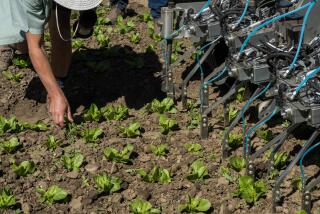Bioengineered Grass Is Cause for Growing Concern
GERVAIS, Ore. — In an unmarked site on the edges of this community of berry farmers, Bob Harriman puts one foot on the world’s most controversial grass.
It’s a blanket of brilliant green -- as thin as a piece of paper and as uniform as cellophane.
If it sounds unnatural, that’s because it is.
The turf is a genetically modified version of the creeping bentgrass popular on golf course greens and fairways, and it is being tested here by Scotts Co., which hopes its creation will be resistant to a common weed-killing chemical.
Scotts keeps the test site incognito because environmentalists are trying to ban the bioengineered grass -- and radical groups have gone so far as to sabotage test plots elsewhere.
Though environmentalists have long opposed bioengineered crops of any kind, this silky turf also has other powerful voices urging caution: the Bureau of Land Management and the U.S. Forest Service.
“Our concern is that if it was to escape onto public land, we wouldn’t know how to control it,” says Gina Ramos, senior weed specialist for the Bureau of Land Management.
Her words conjure an image of a golf course gone berserk -- a state park, for example, blanketed in acres of perfect putting-green turf, with no biodiversity.
Harriman, Scotts’ chief research scientist, counters that numerous studies by the company indicate that the grass is unlikely to spread. The grass seeds are dispersed by flowering blossoms, but the closely shorn turf on a golf course is never allowed to grow tall enough to flower.
The natural version of creeping bentgrass is the perfect surface for a golf ball because, as its name suggests, it “creeps” -- growing in a smooth horizontal plane. But, Harriman points out as he kneels to stroke a patch adjoining the bentgrass test site, the silky smoothness can get interrupted by a coarse weed -- a yellow grass that grows vertically in bunches, like an artichoke. On a putting green that acts as a speed bump, deflecting the ball and frustrating even the most talented golfer.
“Tiger Woods hates this stuff,” Harriman says.
The problem is that trying to kill the weed with an herbicide, such as Monsanto Co.’s Roundup, would also kill the creeping bentgrass.
The grass tested here is engineered to be resistant to Roundup. A superintendent who seeds his putting green with this grass will be able to spray it at will -- and only the yellow weed will shrivel and die, leaving the velveteen bentgrass.
That would be a golf course superintendent’s dream. Of the 15,000 courses in the United States, only the most elite can afford to wipe out the yellow weed, either by fumigating the entire green or by handpicking the clumps.
The bioengineered grass is now in the final stages of approval. The three-month public comment session ended in early March. Among the opponents were environmental groups such as the Sierra Club and the Nature Conservancy, which have long spoken out against bioengineering.
The U.S. Golf Assn. has came out in favor of the biotech grass. After all, 60 different bioengineered crops have received federal approval -- including tomatoes, corn, soybeans, canola, potatoes and papaya trees.
“The irony is you’re cooking your French fries in oil that’s genetically engineered,” says Stanley Zontek, a regional manager with the golf association.
But the Bureau of Land Management and the Forest Service have urged the U.S. Department of Agriculture to delay approval for the turf to do more research on its potential effect.
“What we’re saying is: Let’s be very careful until it’s proven that it’s not going to do the things we’re concerned about -- like take over,” says Jim Gladen, director of the Forest Service’s watershed, fish, wildlife, air and rare plants division.
At the Bureau of Land Management, Ramos stresses that because the grass is resistant to Roundup, it’s unclear how it could be kept in check if it were to escape the confines of a golf course.
“Our budget is already strained trying to control invasive species -- having one more will really be difficult for us,” she says.
Those words of caution from federal agencies have taken some by surprise.
“I’ve never seen it happen before,” says Peter Jenkins, policy analyst for the International Center for Technology Assessment, which advocates for limits on genetic engineering.
Other government voices that have joined the chorus of caution include the Oregon Department of Agriculture and the California Department of Fish and Game, as well as experts with the Army Corps of Engineers, the Pennsylvania Bureau of Forestry and the California Department of Parks and Recreation.
Since the introduction of the first genetically modified tomato a decade ago, bioengineering has been fraught with controversy.
Four years ago, a group dubbing itself the Anarchist Golfing Assn. broke into a seed research facility in Portland, Ore., and stomped on experimental plots, then spray-painted the walls with the slogan, “Nature Bites Back.” In 2000, biotech saboteurs struck more than 20 times in the U.S., including burning the landmark Agriculture Hall at the University of Michigan.
Such attacks make biotech companies nervous, but they are not abandoning their testing. Oregon farmers handpicked by Marysville, Ohio-based Scotts are growing nearly 400 acres of biotech grass in Madras, a three-hour drive from Gervais.
“We’ve been here since the 1970s. It would be un-American to be scared away,” Harriman says. “Why a new use of a safe technology should cause controversy is beyond me.”
More to Read
Sign up for Essential California
The most important California stories and recommendations in your inbox every morning.
You may occasionally receive promotional content from the Los Angeles Times.










